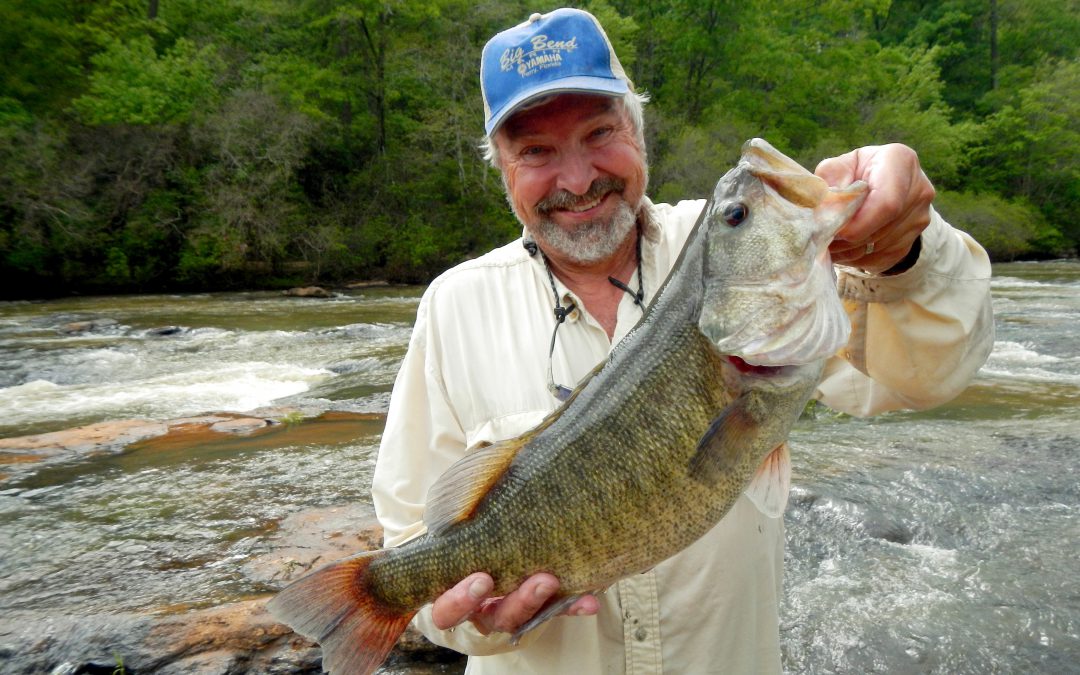
by Andrea Albertin | Mar 20, 2019
By Vance Crain and Andrea Albertin
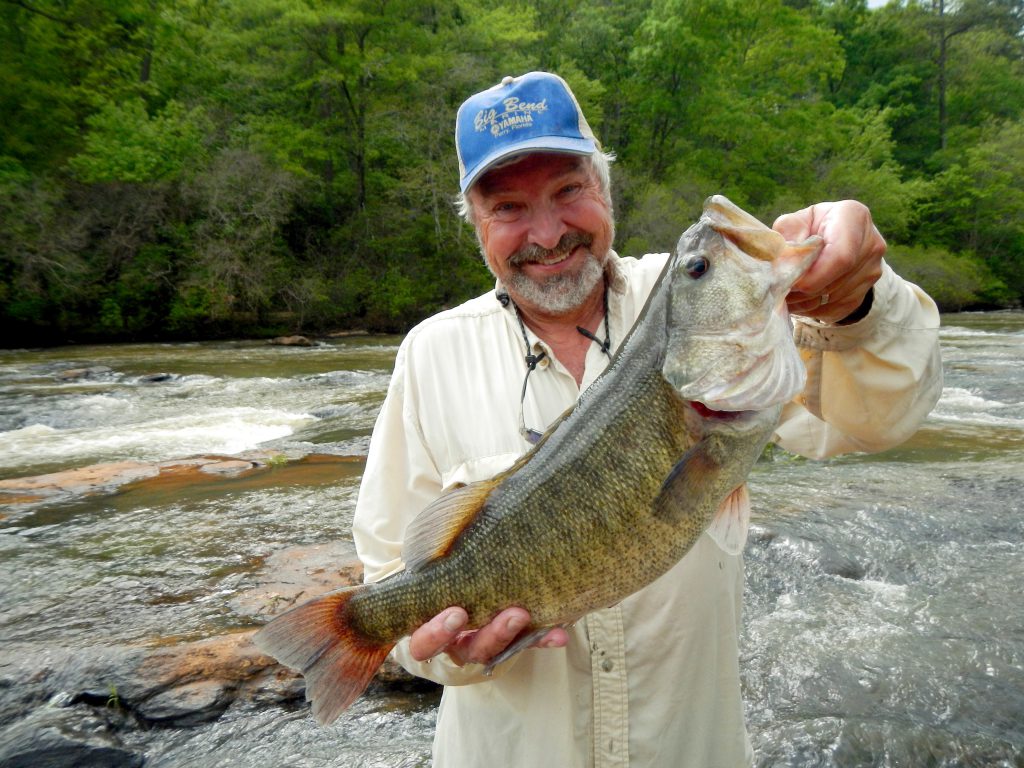
Fisherman with a large Shoal Bass in the Apalachicola-Chattahootchee-Flint River Basin. Photo credit: S. Sammons
Along the Chipola River in Florida’s Panhandle, farmers are doing their part to protect critical Shoal Bass habitat by implementing agricultural Best Management Practices (BMPs) that reduce sediment and nutrient runoff, and help conserve water.
Florida’s Shoal Bass
Lurking in the clear spring-fed Chipola River among limerock shoals and eel grass, is a predatory powerhouse, perfectly camouflaged in green and olive with tiger stripes along its body. The Shoal Bass (a species of Black Bass) tips the scale at just under 6 lbs. But what it lacks in size, it makes up for in power. Unlike any other bass, and found nowhere else in Florida, anglers travel long distances for a chance to pursue it. Floating along the swift current, rocks, and shoals will make you feel like you’ve been transported hundreds of miles away to the Georgia Piedmont, and it’s only the Live Oaks and palms overhanging the river that remind you that you’re still in Florida, and in a truly unique place.
Native to only one river basin in the world, the Apalachicola-Chattahoochee-Flint (ACF) River Basin, habitat loss is putting this species at risk. The Shoal Bass is a fluvial specialist, which means it can only survive in flowing water. Dams and reservoirs have eliminated habitat and isolated populations. Sediment runoff into waterways smothers habitat and prevents the species from reproducing.
In the Chipola River, the population is stable but its range is limited. Some of the most robust Shoal Bass numbers are found in a 6.5-mile section between the Peacock Bridge and Johnny Boy boat ramp. The Florida Fish and Wildlife Conservation Commission has turned this section into a Shoal Bass catch and release only zone to protect the population. However, impacts from agricultural production and ranching, like erosion and nutrient runoff can degrade the habitat needed for the Shoal Bass to spawn.
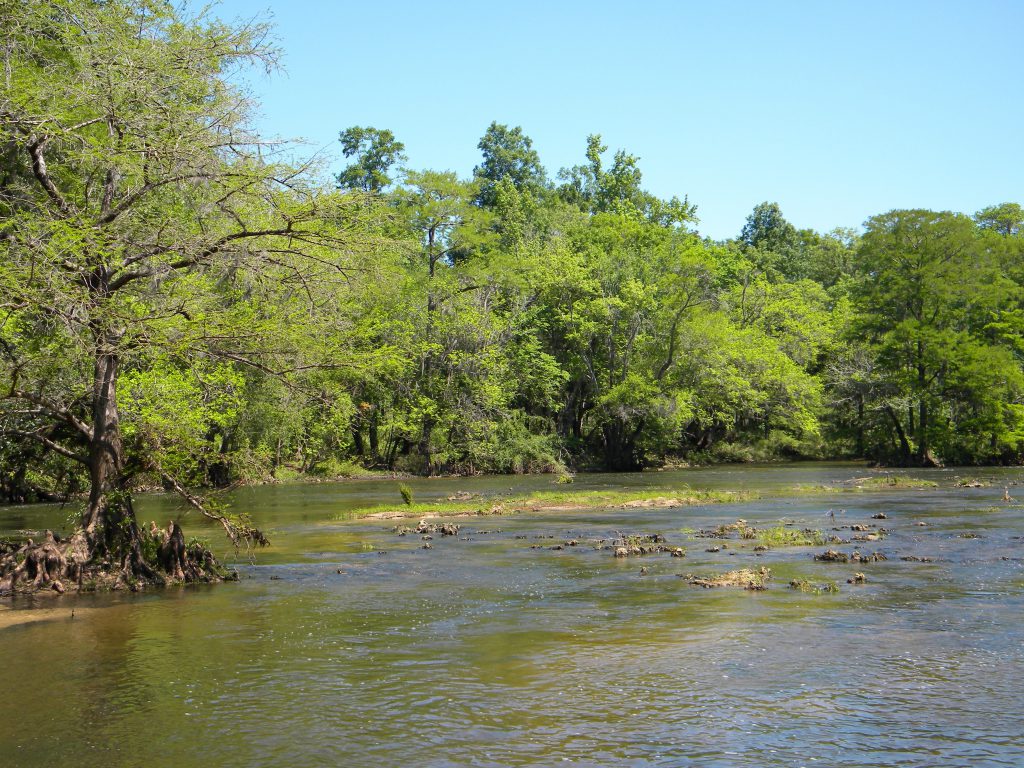
Preferred Shoal Bass habitat, a shoal in the Chipola River. Photo credit: V. Crain
Shoal Bass habitat conservation and BMPs
In 2010, the Southeast Aquatic Resources Partnership (SARP), the National Fish and Wildlife Foundation and a group of scientists (the Black Bass Committee) developed the Native Black Bass Initiative. The goal of the initiative is to increase research and the protection of three Black Bass species native to the Southeast, including the Shoal Bass. It also defined the Shoal Bass as a keystone species, meaning protection of this apex predators’ habitat benefits a host of other threatened and endangered species.
Along the Chipola River, farmers are teaming up with SARP and other partners to protect Shoal Bass habitat and improve farming operations through BMP implementation. A major goal is to protect the river’s riparian zones (the areas along the borders). When healthy, these areas act like sponges by absorbing nutrients and sediment runoff. Livestock often degrade riparian zones by trampling vegetation and destroying the streambank when they go down to a river to drink. Farmers are installing alternative water supplies, like water wells and troughs in fields, and fencing out cattle from waterways to protect these buffer areas and improve water quality. Row crop farmers are helping conserve water in the river basin by using advanced irrigation technologies like soil moisture sensors to better inform irrigation scheduling and variable rate irrigation to increase irrigation efficiency. Cost-share funding from SARP, the USDA-NRCS and FDACS provide resources and technical expertise for farmers to implement these BMPs.

Holstein drinking from a water trough in the field, instead of going down to the river to get water which can cause erosion and problems with water quality. Photo credit: V. Crain
By working together in the Chipola River Basin, farmers, fisheries scientists and resource managers are helping ensure that critical habitat for Shoal Bass remains healthy. Not only is this important for the species and resource, but it will ensure that future generations can continue to enjoy this unique river and seeing one of these fish. So the next time you catch a Shoal Bass, thank a farmer.
For more information about BMPs and cost-share opportunities available for farmers and ranchers, contact your local FDACS field technician: https://www.freshfromflorida.com/Divisions-Offices/Agricultural-Water-Policy/Organization-Staff and NRCS field office USDA-NRCS field office: https://www.nrcs.usda.gov/wps/portal/nrcs/main/fl/contact/local/ For questions regarding the Native Black Bass Initiative or Shoal Bass habitat conservation, contact Vance Crain at vance@southeastaquatics.net
Vance Crain is the Native Black Bass Initiative Coordinator for the Southeast Aquatic Resource Partnership (SARP).
by Andrea Albertin | Jun 8, 2018
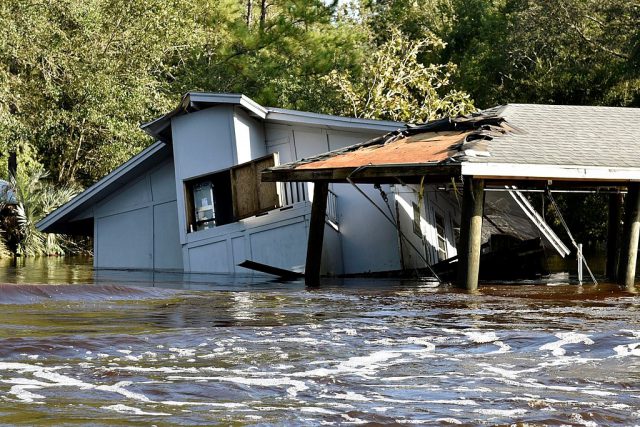
Flooding along the South Prong of the Black Creek River in Clay County on September 13, 2017. Photo credit: Tim Donovan, Florida Fish and Wildlife Conservation Commission (FWC).
As hurricane season is upon us again, I wanted to share the results of work that UF/IFAS Extension staff did with collaborators from Virginia Tech and Texas A&M University to help private well owners impacted by Hurricanes Irma and Harvey last year. This work highlights just how important it is to be prepared for this year’s hurricane season and to make sure that if flooding does occur, those that depend on private wells for household use take the proper precautions to ensure the safety of their drinking water.
About 2.5 million Floridians (approximately 12% of the population) rely on private wells for home consumption. While public water systems are regulated by the U.S. Environmental Protection Agency to ensure safe drinking water, private wells are not regulated. Private well users are responsible for ensuring the safety of their own water.
Hurricanes Irma and Harvey
In response to widespread damage and flooding caused by Hurricane Harvey in Texas and Irma in Florida in August and September 2017, Virginia Polytechnic Institute and State University (VT) received a Rapid Research Response Grant from the National Science Foundation to offer free well water testing to homeowners impacted by flooding.
They partnered with Texas A&M AgriLife Extension’s Well Owner Network (run by Diane Boellstorff and Drew Gholson) and us, at UF/IFAS Extension to provide this service. The effort at VT was led by members of Marc Edward’s lab in the Civil Engineering Department: Kelsey Pieper, Kristine Mapili, William Rhoads, and Greg House.
VT made 1,200 sampling kits available in Texas and 500 in Florida, and offered free analysis for total coliform bacteria and E. coli as well as other parameters, including nitrate, lead, arsenic, iron, chloride, sodium, manganese, copper, fluoride, sulfate, and hardness (calcium and magnesium). Homeowners were also asked to complete a needs assessment questionnaire regarding their well system characteristics, knowledge of proper maintenance and testing, perceptions of the safety of their water and how to best engage them in future outreach and education efforts.
Response in the aftermath of Irma
Although the sampling kits were available, a major challenge in the wake of Irma was getting the word out as counties were just beginning to assess damage and many areas were without power. We coordinated the sampling effort out of Quincy, Florida, where I am based, and spread the word to extension agents in the rest of the state primarily through a group texting app, by telephone and by word of mouth. Extension agents in 6 affected counties (Lee, Pasco, Sarasota, Marion, Clay and Putnam) responded with a need for sample kits, and they in turn advertised sampling to their residents through press releases.
Residents picked up sampling kits and returned water samples and surveys on specified days and the samples were shipped overnight and analyzed at VT, in Blacksburg, VA. Anyone from nearby counties was welcome to submit samples as well. This effort complemented free well water sampling offered by multiple county health departments throughout the state.
In all, 179 water samples from Florida were analyzed at VT and results of the bacterial analysis are shown in the table below. Of 154 valid samples, 58 (38%) tested positive for total coliform bacteria, and 3 (2%) tested positive for E. coli. Results of the inorganic parameters and the needs assessment questionnaire are still being analyzed.
Table 1. Bacterial analysis of private wells in Florida after Hurricane Irma.
| County |
Number of samples (n) |
Positive for total coliform (n) |
Positive total coliform (%) |
Positive for E. coli (n) |
Positive for E. coli (%) |
| Citrus |
1 |
0 |
0% |
0 |
0% |
| Clay |
13 |
5 |
38% |
0 |
0% |
| Hernando |
2 |
1 |
50% |
0 |
0% |
| Hillsborough |
1 |
1 |
100% |
0 |
0% |
| Marion |
19 |
5 |
26% |
1 |
5% |
| Monroe |
1 |
0 |
0% |
0 |
0% |
| Pasco |
40 |
19 |
48% |
1 |
3% |
| Putnam |
61 |
19 |
31% |
0 |
0% |
| Sarasota |
16 |
8 |
50% |
1 |
6% |
| Overall |
154 |
58 |
38% |
3 |
2% |
Of 630 samples analyzed in Texas over the course of 7 weeks post-Hurricane Harvey, 293 samples (47% of wells) tested positive for total coliform bacteria and 75 samples (2%) tested positive for E. coli.
What to do if pathogens are found
Following Florida Department of Health (FDOH) guidelines, we recommended well disinfection to residents whose samples tested positive for total coliform bacteria, or both total coliform and E. coli. This is generally done through shock chlorination by either hiring a well operator or by doing it yourself. The FDOH website provides information on potential contaminants, how to shock chlorinate a well and how to maintain your well to ensure the quality of your well water (http://www.floridahealth.gov/environmental-health/private-well-testing/index.html).
UF/IFAS extension agents that led the sampling efforts in their respective counties were: Roy Beckford – Lee County; Brad Burbaugh – Clay County; Whitney Elmore – Pasco County; Sharon Treen – Putnam and Flagler Counties; Abbey Tyrna – Sarasota County and Yilin Zhuang – Marion County.
We at IFAS Extension are working on using results from this sampling effort and the needs assessment questionnaire filled out by residents to develop the UF/IFAS Florida Well Owner Network. Our goal is to provide residents with educational materials and classes to address gaps in knowledge regarding well maintenance, the importance of testing and recommended treatments when pathogens and other contaminants are present.
Remember: Get your well water tested if flooding occurs
It’s important to remember that if any flooding occurs on your property that affects your well and/or septic system, you should have your well water tested in a certified laboratory for pathogens (total coliform bacteria and E. coli) and any other parameters your local health department may recommend.
Most county health departments accept samples for water testing. You can also submit samples to a certified commercial lab near you. Contact your county health department for information about what to have your water tested for and how to take and submit the sample.
Contact information for county health departments can be found online at: http://www.floridahealth.gov/programs-and-services/county-health-departments/find-a-county-health-department/index.html
You can search for laboratories near you certified by FDOH here: https://fldeploc.dep.state.fl.us/aams/loc_search.asp This includes county health department labs as well as commercial labs, university labs and others.
You should also have your well water tested at any time when:
- The color, taste or odor of your well water changes or if you suspect that someone became sick after drinking your well water
- A new well is drilled or if you have had maintenance done on your existing well
Testing well water once a year is good practice to ensure the safety of your household’s drinking water.
by Andrea Albertin | May 4, 2018
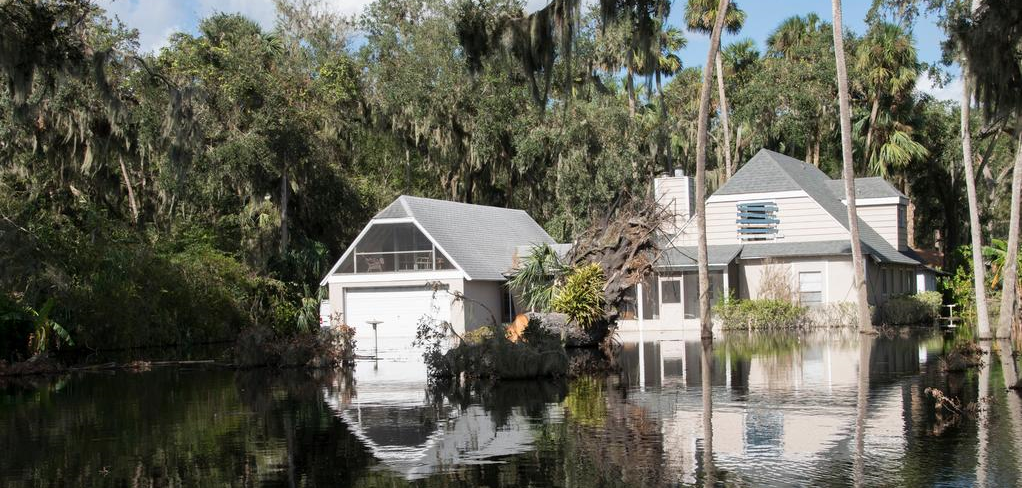
Special care needs to be taken with a septic system after a flood or heavy rains. Photo credit: Flooding in Deltona, FL after Hurricane Irma. P. Lynch/FEMA
Approximately 30% of Florida’s population relies on septic systems, or onsite sewage treatment and disposal systems (OSTDS), to treat and dispose of household wastewater. This includes all water from bathrooms and kitchens, and laundry machines.
When properly maintained, septic systems can last 25-30 years, and maintenance costs are relatively low. In a nutshell, the most important things you can do to maintain your system is to make sure nothing but toilet paper is flushed down toilets, reduce the amount of oils and fats that go down your kitchen sink, and have the system pumped every 3-5 years, depending on the size of your tank and number of people in your household.
During floods or heavy rains, the soil around the septic tank and in the drain field become saturated, or water-logged, and the effluent from the septic tank can’t properly drain though the soil. Special care needs to be taken with your septic system during and after a flood or heavy rains.
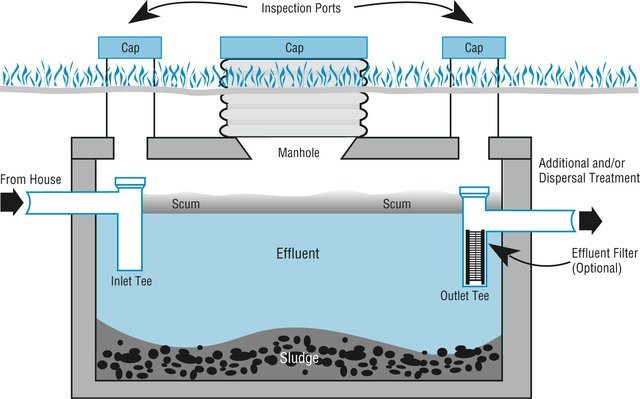
Image credit: wfeiden CC by SA 2.0
How does a traditional septic system work?
The most common type of OSTDS is a conventional septic system, made up of (1) a septic tank (above), which is a watertight container buried in the ground and (2) a drain field, or leach field. The effluent (liquid wastewater) from the tank flows into the drain field, which is usually a series of buried perforated pipes. The septic tank’s job is to separate out solids (which settle on the bottom as sludge), from oils and grease, which float to the top and form a scum layer. Bacteria break down the solids (the organic matter) in the tank. The effluent, which is in the middle layer of the tank, flows out of the tank and into the drain field where it then percolates down through the ground.
During floods or heavy rains, the soil around the septic tank and in the drain field become saturated, or water-logged, and the effluent from the septic tank can’t properly drain though the soil. Special care needs to be taken with your septic system during and after a flood or heavy rains.
What should you do after flooding occurs?
- Relieve pressure on the septic system by using it less or not at all until floodwaters recede and the soil has drained. For your septic system to work properly, water needs to drain freely in the drain field. Under flooded conditions, water can’t drain properly and can back up in your system. Remember that in most homes all water sent down the pipes goes into the septic system. Clean up floodwater in the house without dumping it into the sinks or toilet.
- Avoid digging around the septic tank and drain field while the soil is water logged. Don’t drive heavy vehicles or equipment over the drain field. By using heavy equipment or working under water-logged conditions, you can compact the soil in your drain field, and water won’t be able to drain properly.
- Don’t open or pump out the septic tank if the soil is still saturated. Silt and mud can get into the tank if it is opened, and can end up in the drain field, reducing its drainage capability. Pumping under these conditions can also cause a tank to pop out of the ground.
- If you suspect your system has been damage, have the tank inspected and serviced by a professional. How can you tell if your system is damaged? Signs include: settling, wastewater backs up into household drains, the soil in the drain field remains soggy and never fully drains, and/or a foul odor persists around the tank and drain field.
- Keep rainwater drainage systems away from the septic drain field. As a preventive measure, make sure that water from roof gutters doesn’t drain into your septic drain field – this adds an additional source of water that the drain field has to manage.
More information on septic system maintenance after flooding can be found on the EPA website publication https://www.epa.gov/ground-water-and-drinking-water/septic-systems-what-do-after-flood
By taking special care with your septic system after flooding, you can contribute to the health of your household, community and environment.
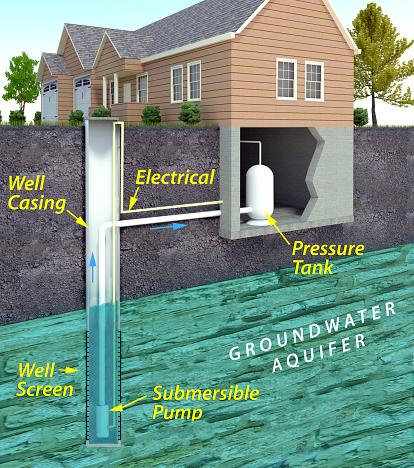
by Andrea Albertin | Mar 18, 2018
An estimated 2.5 million Floridians (approximately 12% of the population) rely on private wells for home consumption, which includes water for drinking, cooking, bathing, washing, toilet flushing and other needs. While public water systems are regulated by the U.S. Environmental Protection Agency (EPA) to ensure safe drinking water, private wells are not regulated. Private well users are responsible for ensuring the safety of their own drinking water.
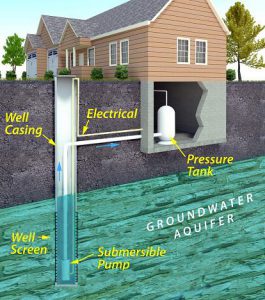
Schematic of a private well typical of many areas in the U.S. Source: usepa.gov
The In Florida, pressure tanks are located above ground since basements are not common. The well casing ensures that water is drawn from the desired ground water source – the bottom of the well where the well screen is placed. The screen keeps sediment from getting into the well, and is usually made of perforated or slotted pipe. The well cap on the surface prevents debris and animals from getting into the well. Submersible pumps (shown here) are set inside the well casing and used for deep wells. Jet pumps are used on the surface and can be used for both shallow and deep wells.
How can well users make sure that their water is safe to drink?
It’s important to have well water tested at a certified laboratory at least once a year for contaminants that can cause health problems. According to the Florida Department of Health (FDOH), the most common contaminants in well water in Florida are bacteria and nitrates.
Bacteria: Labs generally test for Total coliform bacteria and fecal coliforms (or E. coli specifically) when a sample is submitted for bacteriological testing. This generally costs about $25 to $30, but can vary depending on where you have your sample analyzed.
Coliform bacteria are a large group of different kinds of bacteria and most species are harmless and will not make you sick. But, a positive test for total coliforms indicate that bacteria are getting into your well water. Coliforms are used as indicator organisms – if coliform bacteria are in your well, other pathogens (bacteria, viruses or protozoans) that cause diseases may also be getting into your well water. It is easier and cheaper to test for total coliforms than a suite of bacteria and other organisms that can cause health problems.
Fecal coliform bacteria are a subgroup of coliform bacteria found in human and other warm-blooded animal feces. E. coli are one species of fecal coliform bacteria. A positive test for fecal coliform bacteria or E. coli indicate that water has been contaminated by human or animal waste.
If your water sample tests positive for only total coliform bacteria or both total coliform and fecal coliform (or E. coli), the Department of Health recommends that your well be disinfected. This is generally done through shock chlorination. You can either hire a well operator in your area to disinfect your well or you can do it yourself. Information for how to shock chlorinate your own well can be found
Nitrates: The U.S. EPA set the Maximum Contaminant Level (MCL) for nitrate in drinking water at 10 miligrams per liter of water (mg/L). Values above this are a concern for infants who are less than 6 months old because high nitrate levels can cause a type of “blue baby syndrome” (methemoglobinemia), where nitrate interferes with the capacity of hemoglobin in the blood to carry oxygen. It is particularly important to test for nitrate if you have a young infant in the home that will be drinking well water or when well water will be used to make formula to feed the infant.
If test results come back above 10 mg/L, never boil nitrate contaminated water as a form of treatment. This will not remove nitrates. Use water from a tested source (bottled water or water from a public supply source) until the problem is addressed.
Nitrates in well water come from fertilizers applied on land surfaces, animal waste and/or human sewage, such as from a septic tank. Have your well inspected by a professional to identify why elevated nitrate levels are is getting into your well water. You can also consider installing a water treatment system, such as reverse osmosis or distillation units to treat the contaminated water. Before having a system installed, make sure you contact your local health department or a water treatment contractor for more information.
Where can you have your well water tested?
Most county health departments accept samples for water testing. You can also submit samples to a certified commercial lab near you. Contact your county health department for information about what to have your water tested for and how to take and submit the sample.
Contact information for county health departments can be found on this site: http://www.floridahealth.gov/programs-and-services/county-health-departments/find-a-county-health-department/index.html
You can search for laboratories near you certified by FDOH here: https://fldeploc.dep.state.fl.us/aams/loc_search.asp This includes county health department labs as well as commercial labs, university labs and others.
You should also have your well water tested at any time when:
- The color, taste or odor of your well water changes or if you suspect that someone became sick after drinking your well water.
- A new well is drilled or if you have had maintenance done on your existing well
- A flood occurred and your well was affected
Remember: Bacteria and nitrate are by no means the only parameters that well water is tested for. Call your local health department to discuss your water and what they recommend you should get the water tested for. The Florida Department of Health (FDOH) also maintains an excellent website with many resources for private well users: http://www.floridahealth.gov/environmental-health/private-well-testing/index.html . This site includes information on potential contaminants and how to maintain your well to ensure the quality of your well water.
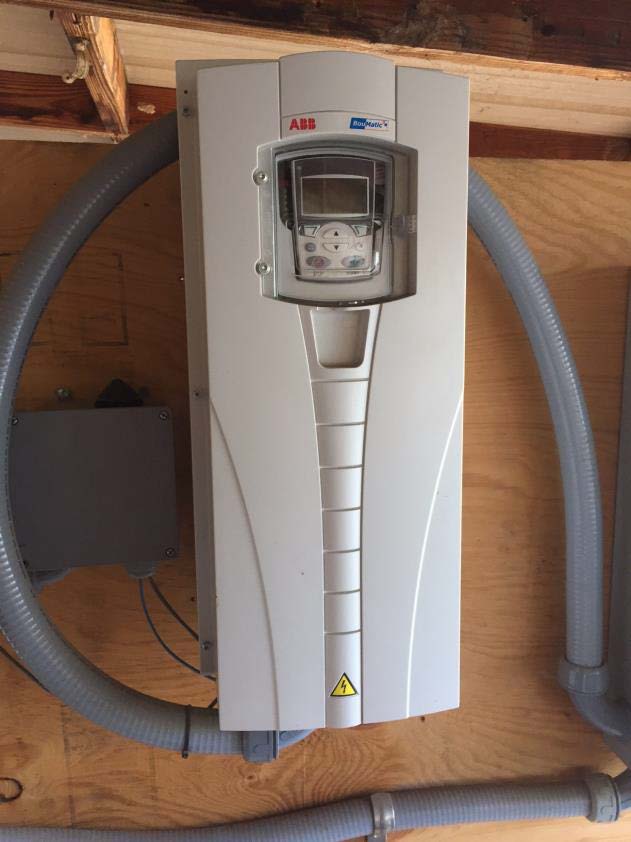
by Andrea Albertin | Jan 19, 2018
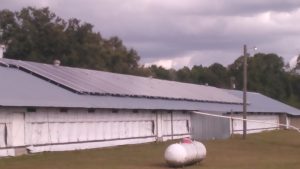
A poultry farm in North Florida used FDACS cost share funds to install solar panels for renewable energy production. Photo source: FDACS Office of Energy
Maximize your farm’s energy savings with FDACS’ free energy evaluations and cost share program
The Florida Department of Agriculture and Consumer Services (FDACS) Office of Energy is currently offering free energy evaluations and cost share funds to increase on-farm energy efficiency to agricultural producers in Florida. This includes all types of operations, such as row crop, fruit and vegetable farms, nurseries, livestock and poultry operations, dairies, and aquaculture farms.
What is an energy evaluation and how is it done?
The purpose of the free evaluations (which are valued at $4,500) is to let producers know how they can maximize energy efficiency and ultimately reduce costs on-farm. During these evaluations, members of a Mobile Energy Lab (MEL) walk through the operation with the producer, evaluating all forms of energy use. Since energy use is often linked to water use (irrigation pivots, for example), the team also assesses water use.
MEL teams are made up of energy experts contracted by FDACS from one of three universities: Florida A&M University, the University of Central Florida and the University of Florida. The MEL will be made up of members from the university closest to the farming operation being evaluated.
After the MEL team has finished the on-site visit, it prepares an evaluation and sends it to the producer. The evaluation details energy use and makes recommendations about how to increase efficiency on-farm. These recommendations depend on the operation and what the farmer is interested in doing. They can include switching to more efficient lighting, converting irrigation pumps from diesel to electric, using variable frequency drives (VFDs) on milk vacuum pumps in dairy operations and switching to or adding small-scale renewable energy generation, like solar or biomass, among others.
After a producer decides on changes she or he would like to make, FDACS offers 80% reimbursement (or cost-share) up to $25,000 to implement recommendations made in the evaluation.
An additional advantage of having a free energy evaluation completed by the MEL is that the evaluation can be used to apply for cost share funds from the USDA-Natural Resources Conservation Service (NRCS) Environmental Quality Incentives Program (EQIP). Producers could potentially receive cost share dollars from both FDACS and NRCS to increase on-farm energy efficiency.
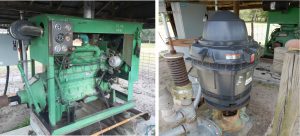
A producer in the Suwanee Valley took advantage of cost share funds to switch from using a diesel irrigation pump (left) to an electric pump (right). Photo source: FDACS Office of Energy
What is the timeframe for applying for energy evaluations and cost share funds?
FDACS offers statewide evaluations and cost share through their FRED Program (Farm Renewable and Efficiency Demonstration). These funds are set to expire September 2018, and so any items or equipment obtained with cost share funds must be purchased and installed by September 2018.
To have enough time to apply for and receive an energy evaluation (which is the first step to obtaining cost share funds), applications for evaluations must be turned in to FDACS by February 1, 2018.
The good news is that a similar program will continue after September. However, it will be in a more geographically restricted area. The Office of Energy received BP RESTORE funds to continue funding energy evaluations and cost share in the Apalachicola and Suwannee River Basins. These funds will be available starting this spring. The office hopes to secure more RESTORE funds in the future to expand the geographic reach of the program.
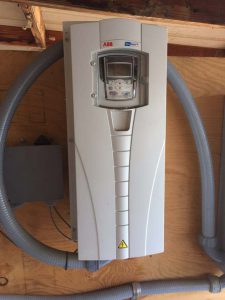
It’s estimated that dairy farms with 50 cows or more could save 40-55% of milk vacuum pump costs by using a variable frequency drive or variable speed drive (VFD) (shown above) on milk vacuum pumps. Photo source: FDACS Office of Energy
Who is eligible for energy evaluations and cost share funds?
Producers that are eligible for NRCS EQIP funds are eligible for this energy program. As stated by FDACS, this means a producer has to:
- Have control of the land for the term of the proposed contract period.
- Be in compliance with the highly erodible land and wetland conservation provisions described in 7 CFR (Code of Federal Regulations) Part 12.
- Have an interest in the agricultural operation as defined in 7 CFR Part 1400.
- The average adjusted gross income of the individual, joint operation or legal entity, may not exceed $900,000
If you have any questions about these requirements, please contact Takara Waller at the Office of Energy (contact information listed below).
How do you apply for an energy evaluation?
To apply for an energy evaluation, you need to submit an application to the FDACS Office of Energy. Application forms and instructions on how to submit them, as well as more information about the program can be found at http://www.freshfromflorida.com/Business-Services/Energy/Incentives-for-Agriculture-Producers
If you have any questions, Takara Waller from the Office of Energy can help guide you through the process. Her contact information is:
(850) 617-7470 (phone)
(850) 617- 7471 (fax)
Takara.Waller@FreshFromFlorida.com
For more information about NRCS EQIP cost share funds, contact your local NRCS office. Contact information for offices in the panhandle region can be found at https://www.nrcs.usda.gov/wps/portal/nrcs/detail/fl/contact/local/?cid=nrcs141p2_015022
Your local USDA Farm Services Agency can also provide more information about cost share programs related to energy. Contact information by county is found by selecting (or clicking on) the county of interest on the following map https://offices.sc.egov.usda.gov/locator/app?service=page/CountyMap&state=FL&stateName=Florida&stateCode=12.
Remember: an energy evaluation is the first step in obtaining cost share funds to increase on-farm energy efficiency and savings.













